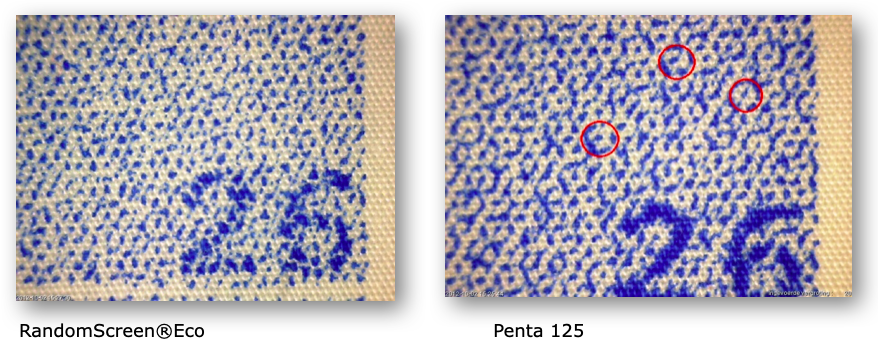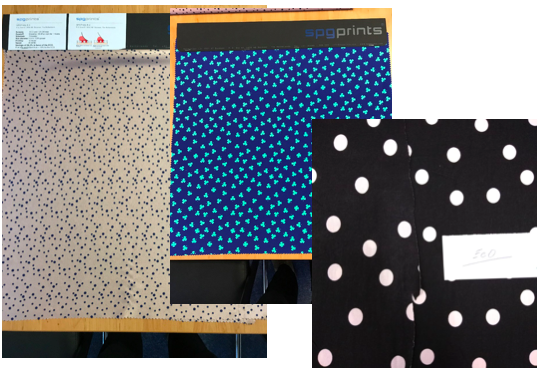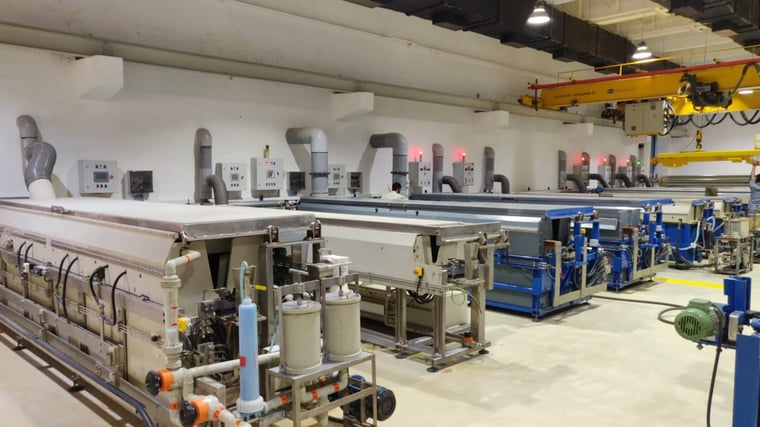In rotary screen printing, several factors influence the quality of your printing results, such as the printing paste and the screens you use. The price you pay is — of course — also related to these factors. There is good news about that. SPGPrints introduced a way to reduce process costs and improve product quality, without having to change the process itself. This will increase your competitiveness in the printing business.
We developed RandomScreen® Eco specifically to be both economically and technologically advantageous. The most important adjustment? This screen allows more control on the print process and paste deposition than standard 125mesh screens. It brings other interesting features like a random adjustment of the holes and superior stability.
Rethought: how does this lead to savings?
In the 1970s, the 125 mesh technology was a major breakthrough. The resolution in combination with the high open area of that screen was not seen before in rotary screen printing. It turned out to be the perfect match between economical and technical needs. It is by far the most sold rotary printing screen to this day.
The popularity of this screen type among a huge group of printing companies created a market, where printing companies have difficulties to generate unique quality but are mostly competing on price. With this in mind, the RandomScreen® Eco screen was developed. With increased print quality and additional economic advantages, it can be considered as a “rethought version” of the original 125 mesh screen.

The screen is made like a Nova screen. The screen holes are streamlined. The paste transfer to the substrate can be achieved with clearly less printing pressure. This has a couple of advantages. The paste can be kept at the surface of the substrate. This counts for pigment printing. The Nova-shaped holes ensure a perfect surface coverage without un-printed spots. Therefore the consumption of paste can be considerably lower than with a standard 125 mesh screen, where more printing stress has to be used to cover the printing fabric sufficiently. Surface printing means that the hand-feel of the textile is better since less binder is used. The textile is barely affected and the hand feels more natural. The shade impression of the print is brighter since the fabric is not interfering in the remission of light. And the good news is, that this is all achieved by using 15-25% less paste. The paste costs are making up for a good portion of the process costs, so this is a big economical win.
Advantages are also proved in reactive and disperse printing. The RandomScreen® Eco is a tool for the printer to control the print to the necessary level of penetration and not beyond that. This is also leading to savings and improvements in the washing off process and with this also in the wash fastness.
Same parameters, a new screen
The new RandomScreen® Eco may have a lot of advantages, but not many companies are eager to adjust their printing process parameters. At SPGPrints, we understand that very well.
With the RandomScreen® Eco screens, exactly the same printing conditions can be applied as used with regular 125mesh screens. In other words: you don't have to worry about changing your processes. The only change in the process is the screen itself. The following aspects of the screen play a role in the improvement of the printing process:
1. Hole shape
Nova-shaped holes reduce the printing pressure. RandomScreen® Eco uses Nova technology but reduces the size of the holes even further. This smaller hole shape ensures that it is not necessary to reduce the pressure. The paste flow will not be reduced by means of less printing pressure, but the diameter of the screen holes will restrict the flow of paste to the necessary level into the printing fabric.
In case full penetration is necessary, this is also possible. Like with any other screen this can be achieved by increasing the printing pressure.
2. Screen thickness
The screen is thicker than the 125 mesh Penta screens. The 125 mesh has a thickness of 100 microns; RandomScreen® Eco has a thickness of 115 microns. Because of this, the RandomScreen® Eco screens are more stable and have a longer life span. A difference of just 15 microns in thickness can ensure the screen is twice as stable. More advantages derived from the increased stability are a better shape consistency during the engraving and printing process. Simply spoken, after un-packing this screen gets back to its round shape much better than regular 125mesh screens. This will benefit the evenness of the screen coating and the fitting properties of the screen.
3. The positioning of holes
The holes of RandomScreen® Eco are, like the name suggests, positioned randomly. The random positioning of the holes in the screen takes away the regularity, which is a good thing if you want to suppress moiré, as it may happen in halftone printing. The random positioning of the holes prevents repetitive mismatches between the screen and the raster of halftone designs.
Proven performance
To demonstrate what this technology could mean for our clients, specialists of SPGPrints carried out customer trials. These tests were done with pigment, reactive and disperse pasts and a saving effect between 15% and 26% was realized.
 The conclusion of the customer trials was very positive: the RandomScreen® Eco leads to more than 25% savings in paste. In turn, this paste saving leads to substantial cost savings. Therefore the screen is also contributing to sustainability. Less paste means less usage of recourses. With their enhanced stability the screens are also convenient for re-use.
The conclusion of the customer trials was very positive: the RandomScreen® Eco leads to more than 25% savings in paste. In turn, this paste saving leads to substantial cost savings. Therefore the screen is also contributing to sustainability. Less paste means less usage of recourses. With their enhanced stability the screens are also convenient for re-use.
What does this mean for your company?
In the process of determining whether the RandomScreen® Eco is suitable for your rotary screen printing process, the screens could be tested in your production. We can assist you and carry out a TCO calculation of your printing process for the RandomScreen® Eco and a regular 125Penta screen. Contact us here and plan a free trial for your printing process.





